OFF-TOPIC (32)
By:
August 24, 2021
Off-Topic brings you over-the-transom, on-tangent essays, dialogues and subjective scholarship on an occasional, impulsive basis. For this season of unforeseeable fates, a counsel among cultural explorers with some creative instincts and humane ideas about how to retrace the footsteps to our future…
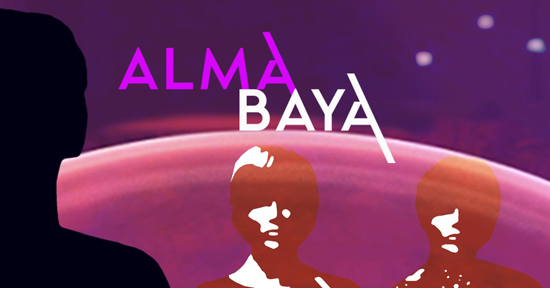
Two women sit in the austere blankness of a hexagonal pod in the midst of an indeterminate wasteland. They exchange arcane, elliptical jargon about how to keep their life-support functioning and what to do with themselves. We are in the tabula rasa of Waiting for Godot, but drama abhors a vacuum, and details sketch in quickly: Alma and Baya, their names like labels on lab subjects, live in an outpost on an unnamed barren planet, where they have been placed, from birth, as a test of the ecosystem’s ability to sustain humans. Reality is absurd enough, and in the post-late-capitalist era we make our limbos literal. That the self-endangered human race has started looking for some other planet’s natural conditions to “fix” is one of many ironies lost on Alma and Baya; and, by design and destiny, they continually have more immediate things to worry about.
Like the Stranger, who appears banging on the outside of their walls. Alma and Baya have been reduced to eating anonymous nutrition-patties since their containment suits stopped working, rendering it impossible to venture out and tend the small agricultural plot their “creators” set up for them (“I miss the crops,” mourns Baya, not perceiving that she and Alma are what’s really being cultured here). The Stranger has gotten to their pod in such a suit, and the pair debate whether to let her in (and risk a survival struggle over scarce sustenance) or let her expire (so they can inherit the suit). The creators have imposed a binary (dominant, supervisory “Alma”s and dutiful, laboring “Baya”s) that the Stranger breaks; she is the serpent of knowledge — other views, possibilities — in their eden of unawareness.
Alma sees it in almost such biblical terms, considering the Stranger an “infection” of their orderly existence and purpose (once she inevitably gets in), and saying as much in her regular transmitted reports to the absent creators, which are delivered as the closest thing these two-person societies have to prayer. Facts matter, but we don’t survive without belief, and even though the creators have left Alma and Baya a multi-volume instruction manual that more or less lays out the strict details of why they are there, the pair has re-mysticized it, with ritual gesture and wistful conjecture.
Alma Baya the play is running both in-person (though strictly COVID-protected) and online, and (as one of the COVID protections) with two separate casts on most alternating nights. In the cast I saw, Maggie Cino is a silently explosive portrait of self-imprisoned feeling as Alma; JaneAnne Halter is heartbreakingly trusting and surreptitiously principled as Baya; and Nalina Mann is an astonishing presence as the Stranger, her performance a feral ballet of protective crouches, striding confidence and abject collapse; the natural, ungoverned world the other pod-dwellers fear, personified. I spoke by viewscreen with the cast and playwright Edward Einhorn, to share more understanding of who these characters (and actors, and audience) all are…
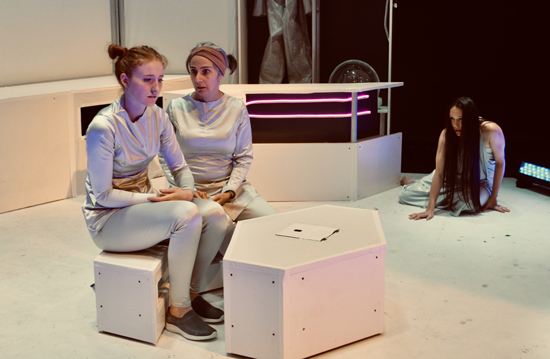
HILOBROW: I was struck by how movement-based this performance feels; everything from the tension between the relative rigidity of the people who’ve been staying in the pod and the kinetic restlessness of the Stranger, to all the little ritualistic gestures that people make before eating, reciting the manuals, and other daily duties. Was that scripted, or workshopped amongst yourselves? (I guess I could ask if all of this is the same with the other cast, since I haven’t seen that version!)
HALTER: What’s so great about working with Edward is the freedom that he’s given us. With a lot of other directors it hasn’t been that way; sometimes you show up to the room and they have this whole concept for each person, and the actor sort of fills in for that physically. But Edward has been amazing with being so open and letting us explore.
EINHORN: I usually try to have the work at least somewhat come from the actors, but more so this time, because of the A and B cast. I really wanted them to develop the world for themselves. I certainly was aware of certain things with casting. Like, both Strangers I cast for very movement-oriented people; I always envisioned the Stranger as a very movement-oriented character. So, it evolved from the actors, but with those actors I wasn’t so surprised that it evolved that way. Maggie completely came up with the ritual movements, and I was really excited about it also because it wasn’t in the other cast. So it was a different way to approach it. If there’s a manipulation on my part, it was creating a set, a space that forced them to have a certain set of movements. You have a back ledge without steps, you have strange furniture that’s also machines, so I knew that there was going to have to be some sort of adaptation into that world. But I wanted to let them find what that adaptation was. I wanted to create an environment that both casts could find themselves in. Were you going to say something, Maggie?
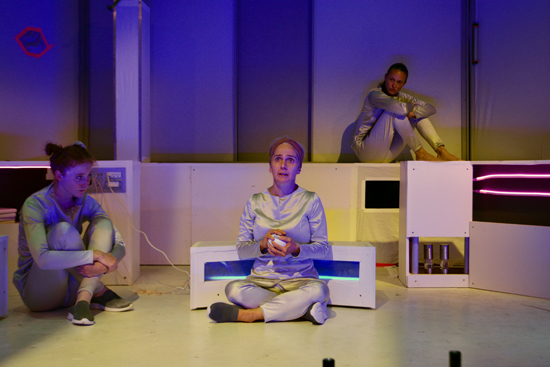
CINO: I was just gonna talk about the gestures. The gestures felt really important to me. Because there were a couple things with [Alma], where on the one hand I just kept having this intuition that she wanted things to do with her hands all the time. Also it just really felt like, “Oh, they’re in this weird pod, there’s not a lot of stuff, there’s not a lot of things that make it personal; what are the ways that they’ve developed through the day to connect with each other, to make order and meaning, to make things feel special, to give themselves a sense of event.” I was thinking of it too with the pandemic and everything that happened; definitely at our house in the beginning, having a sense of things being special, and set apart, and meals being special, and set apart. When you’re cut off from the outside and cut off from the normal routine of the day, the things that you develop to make your life feel orderly and meaningful and important.
HILOBROW: And I guess it affords them some agency… some rule, custom, process that they can set, since they’re always jumping at various alarms or signals for when it’s time to eat, etc. I guess the same could be for all of us who were locked in ourselves; what can we bring to this, what can we write of this day.
CINO: And how do you control time a little bit, even if it’s just taking a second before you eat your weird sad food.
HILOBROW: I found it interesting that your Alma is so restricted in her motion… of course, it is a one-to-one match with her personality, but I thought it was interesting that someone who creates movement chose to do this rigid character.
CINO: In the directing that I’ve done, a lot of the work is physically based, because that’s my background. It was interesting with her, it’s funny that you said that, because I almost feel like, because of the demands that the set put on us, she’s actually more limber than in a different environment I would have made her. I think a lot of it is just what you said; there’s something very… she’s always on the job, she’s always watching, she’s always making calculations; even when it’s just Alma and Baya there’s still so much she’s looking out for, and so much she’s paying attention to. And when the Stranger comes in, and there’s that added level of danger, there’s an alertness to her where she doesn’t want to make a false move, and feels in a big way like she can’t afford to. And so, [movement] is something that she just needs to do as quickly and efficiently as possible to get the job done. Because, in so many ways she feels like she doesn’t have a lot to waste.
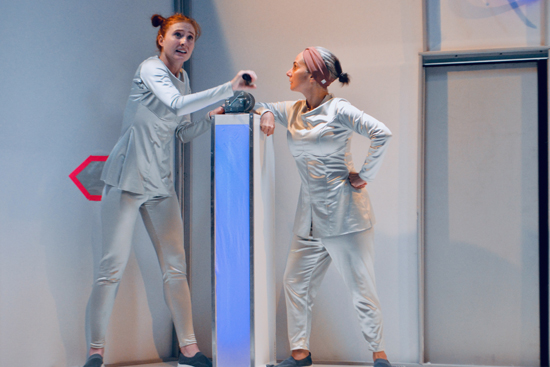
HILOBROW: It’s paradoxically hard to… generate an absence. I mean, these three characters are all innocents, in a way. The way they talk, the way they relate to reality and each other, reminds me of people who were raised in a cult, or some kind of intentional community. How did each of you approach forming these characters who kind-of have no context and no past, even though they’ve had a life before the moment of the play.
MANN: I guess, when I was looking at lines — and I do have a lot of lines where Alma and Baya have knowledge that I don’t have, my pod seems to be more primitive. So, I took that very much at face value. Rather than asking things like, “what’s an animal,” or “how do you know how humans act” from a sarcastic standpoint, which would presuppose that I knew what they were, and was poking at Alma and Baya, I really am legitimately asking. Like, I’ve never heard of an animal. What’s a “key”? I’ve never seen one. In my pod that doesn’t exist. So it was an interesting challenge to figure out how to ask questions like that completely innocently and completely face-value. And to figure out what things I do know, and what things I don’t. What things are universal to the pods and what things only exist in this more sophisticated pod.
HILOBROW: You’re taking me back now to how really compelled I was to wonder, how much does the Stranger know, and what was her life before this.
MANN: That’s what makes her so fun! That’s the fun of the part.
HILOBROW: It’s funny you should say “less sophisticated” because to me it seemed like it was more advanced — apparently she and her partner didn’t have as detailed a set of books to tell them when to breathe, etc.
MANN: In the backstory that I’ve come up with, my pod may have been less technologically advanced but I think we were more emotionally advanced; that my partner and I actually had a relationship of some kind that this Alma and Baya don’t know about. They’re disconnected from the physical side of things, they’re disconnected from the love part, that seems to have existed in my pod.
CINO: To that point, one of the things, before we even started rehearsing, that I was thinking about was — do you know that Ishiguro novel, Never Let Me Go? The one about the kids in the school, but they’re actually there to be harvested for their organs. And there’s a thing in the book about how there was a big social movement to get them educated, because otherwise they were literally just grown like plants. And I was thinking, with Alma, and with the two of them, well, what was before this? Were we just grown like plants in an incubator? And I started to read all this stuff about the famous, terrible Romanian orphanages, and what happened to those kids. And thinking, much to Nalina’s point, we were put here, and we were given these instruction books, but we’ve only had each other, there’s no mention of any parent figure or any caretaking figure; we’ve had to just sort of work it out for ourselves.
And even with the “pleasuring yourself” [a mannerism Alma misinterprets from the creators’ elliptical leisure instructions], if you read about it, if you don’t have good attachment parenting, one of the things if you have a very traumatic upbringing that people do to sooth themselves is, literally, rock and punch, it’s like rocking and punching and rocking and punching. So the idea that we are very emotionally stunted and very hungry for what the Stranger brings, even as it’s terrifying, felt really real.
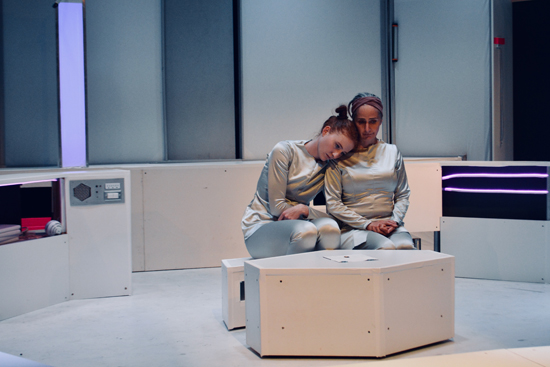
HALTER: For me, I just feel so lucky, because when I was reading Baya for the first time — there are just those characters that you just know. Like, I know who you are, I know how you are, and I just feel so lucky that Edward and I had the same idea of who she is and how she is. And because it was so easy to relate to her, it’s joyful and easy for me to be her; I think she’s just this innocent little girl. And because of that I feel like she doesn’t put a lot of thought into how they got there or why they’re there, because the books say all of those things, and she believes them, and she’s like, Yes, this is it. And she has her jobs, she spins the wheels and checks the dials, and that fulfills her. And because she’s the workhorse of the pod, at least in our interpretation, that’s all she needs. And I do think that it is a genuine satisfaction with, Okay, this is my life, this is what I do, and the books explain why I’m here, and they are correct, and they’re truthful.
HILOBROW: When you say that, it only makes me realize now that there’s this dynamic between discontent and contentment, which puts in a different context what Maggie was saying about the nervous gestures and economy of Alma. Because, even as she’s so by-the-book, she is continually talking about escaping — or at least getting out of this phase of their life. Cause it’s always, “When the Creators come back,” etc. Whereas I get the impression, like you, that Baya would be happy for this to continue indefinitely. … Even though she welcomes the disruptive, dynamizing arrival of the Stranger in ways that Alma doesn’t.
EINHORN: There was an interesting moment when Maggie was asking me, “What does Alma actually do?” [laughs] “What does she contribute?” I think the answer is that she contributes meaning. And I think that actually sustains them both, in this particular pod. Whereas Nalina’s pod… does not have that, as a base thing. I guess in a certain way it correlates to what we would think of, in an old way of thinking, as the more traditionally “civilized” and the less civilized; the Western Civilization, where we do things the right way and we have our rituals and we have a whole set of meanings that we’ve given to these things. But there’s a certain sort of knowledge that the Stranger brings that they have no access to whatsoever on their own.
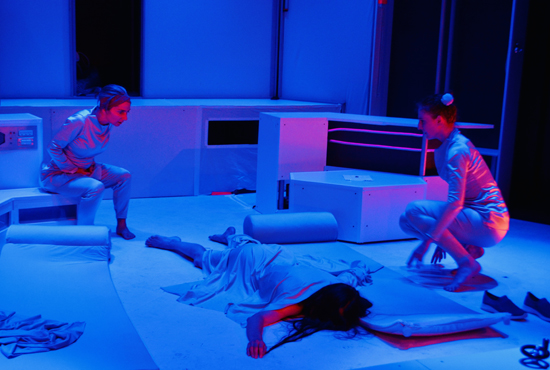
HILOBROW: It seems to me that this is a COVID-era drama, in terms of both the viral and cultural contamination anxiety, that’s felt particularly by Alma. To what extent was this narrative a product of these times for you?
EINHORN: It was not really a COVID-inspired thing. Maybe a Trump-era-inspired thing! It fell into COVID stuff. But I think it’s really like, sort of examples of human difficulty and human struggle, in dealing with innate selfishness, and resources; things like that certainly come into play. But yes, I understand why it resonates in a particular way during the COVID era, though it was pretty much written beforehand.
HILOBROW: In terms of this being serendipitously adjacent to some of the concerns of the COVID era, it’s hard for me to think of another play that comments on contemporary events and human emergencies in a way that’s so to-the-point without being on-the-nose. We have the manuals as the Bible, and the transmissions to the creators as prayer, and very specifically (though you couldn’t have foreseen this since it was happening as the play debuted) we have Alma talking about the infection that the Stranger brings, right as the Republicans were shifting from claiming COVID is a hoax to saying immigrants are all bringing it in. Did you try and take yourself to a tabula rasa point like the characters themselves, to build up how certain things like this would come about — the tribalism, the construction of a faith of sorts? That’s not so easy to do; it would be easy to descend into one-to-one satire, but this feels organic and almost like I have this window back to… to be personal about it, this is the closest I think I’ve ever come to feeling a real connection to what the early Hebrews must have been like; what they had to work with, what limitations their perceptions developed within…
EINHORN: We were talking about the times, and I was reminded that, y’know I started doing the Ionesco Festival right before 2001, and everyone was like, “What does Absurdism have to do with our society today?” Because it was late-’90s going into 2000s and nobody thought our American society related to the absurdism of post-war [times]. And then 9/11 hit, and everyone was like, “Oh this is so relevant, how did you know?” But that’s what Absurdism is; it’s speaking to the times of difficulty when things get… these sort of dark and comic times. Certainly the association of immigrants and infection is not new; of course it’s cropping up again as it always does at such times. It’s not hard to be prescient in a certain way, because it just keeps recurring again and again.
So, my hope was to sort of distill humanity into this little pod, and to be able to address all these major issues in that way. And see what naturally would live in that pod, given the crisis that I decided on, that would bring out certain aspects of the people as a result. And then, I have obsessions about religion, and where religion comes from, and our predilection towards religion and all that; so of course that sort of worms its way in. It’s all a little bit subconscious because it’s just things I’m really interested in that I create a scenario, like a little Petri dish where they could grow.
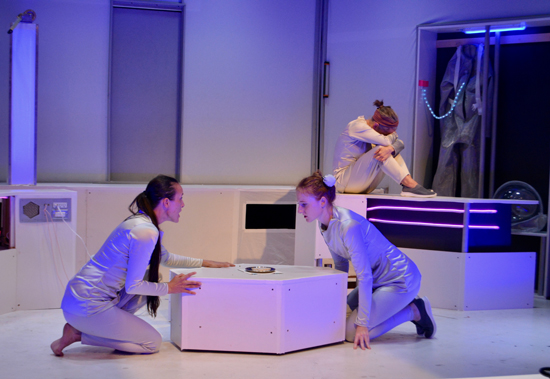
HILOBROW: On the other side of “contamination” — it’s apropos Edward that you said “like a Petri dish” because there certainly is this laboratory feeling to the set. It reminded me of a number of 1970s dystopia films, where what was sterile was more scary than what was squalid. I’m thinking of everything from Clockwork Orange’s settings to the suicide clinic in Soylent Green to any spaceship interior designed by Douglas Trumbull. Did you do any thinking about that interplay between the anxiety of contamination but also the anxiety of, I guess, isolation? Because certainly the Stranger is the proof that there’s an amount of cross-pollination that we should embrace.
EINHORN: I think there’s definitely a connection between the sterility of the set and this idea of purity, of the Alma/Baya idea. The other things I was thinking about, in the sort of menace of the set, was that I don’t want there to be any furniture, and I don’t want it to be easy to move around this place. It’s almost like you go to the zoo to see the lion and they’re in the boiler room. But they’ve found a way to decide that that was their home, and function there. And also that it is not a place that you can imagine their living ’til 80 and still living there. Whoever created that place assumes that they’re going to die young. So it looks science-fiction-y and sterile, but there’s something innately cruel in its design.
HILOBROW: This is, in some ways, an emergently unique kind of production; I can’t think of many other eras, or many other cases, where actors (and writers) had to be conscious of both the reaction of people they’re interacting with in the theatre space, and how they look on camera. I’m curious what thought you gave to how this would work simultaneously for screen and stage?
I don’t know if, in the actor’s case, maybe you don’t deal with it — it just drives you deeper into the reality of the performance, and the observation will kind of sort itself out — or if you think about what will be effective on two planes. On the writer and director’s side, I — watching at home, I did get the eerie feeling that I was seeing an actual transmission from this pod. And I was unexpectedly scared, simply by the blackouts between scenes, because it felt like, “CAN YOU HEAR ME MAJOR TOM?!” — and I wouldn’t have gotten that if I were just sitting in the theatre. … So, what were your considerations, or what were you even conscious of, in terms of this being experienced by two very different audiences?
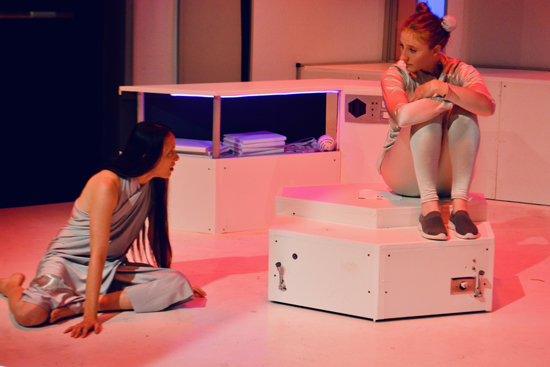
MANN: I’ll bite. [laughs] For me in general I always find that any time you can stream live theatre, that’s exciting, because you get to see something you wouldn’t necessarily be able to go see, like all of the things the National in London was feeding us earlier in the pandemic. But also I’m always a little bit conscious of what I’m losing, because live theatre is supposed to be live. I think our taping is very similar to theirs, in that they’re not trying to do the movie broadcast version, they’re just putting a camera somewhere and letting you see the show. And I guess I didn’t change anything in my process because of the video… but I’m always a little worried that some of the details wouldn’t be seen because in the room, the angles are different, so the physical things that we’re doing, the small eye gestures, the hands, the toes that are moving, the whatever’s happening, that the camera wouldn’t pick that up, and that the home audience would miss out on something. But from what you’re saying there’s this whole other element that I didn’t even think about, that you are basically the people that Alma and Baya are transmitting to every month — so, layers upon layers upon layers.
HALTER: I made the conscious decision to not think about the fact that I was being filmed! But I think I was able to let go of it so quickly because Edward’s writing is so good; the story alone, on the page, is so captivating, that we were just sort of the cherry on top of what had been created. So I [thought], “this story’s gonna come through, regardless,” and it will be interesting and meaningful, regardless of the little movements or gestures here and there. So I was like, “Yeah. I’m not gonna think about the fact that I’m being filmed.” [laughs]
CINO: I was super worried about it. For a couple of different reasons. Like Nalina was saying, part of what you’re doing with theatre is the experience of being in the room, and the whole way the artform is set up is it’s more than the sum of its parts, it’s the energy in the room, it’s the connection with the audience, it’s what happened in the news that day, it’s about that dialogue. So any form of filmed theatre always carries a question-mark for me.
And the other part, which I think is the biggest part — because I’ve never been in a situation where something’s been recorded and then has been sold as The Show — is like, for me at least, it’s never “done.” There’s always a process. The great thing about performing live is there’s always layers and discoveries and texture to be added. And, while I feel good about [the recorded version], there’s nerves that I have about people approaching it like, “oh, this is the definitive thing, this is what it’s supposed to look like.” Because I feel like the great thing about live theatre is… it’s always going to be a bit different.
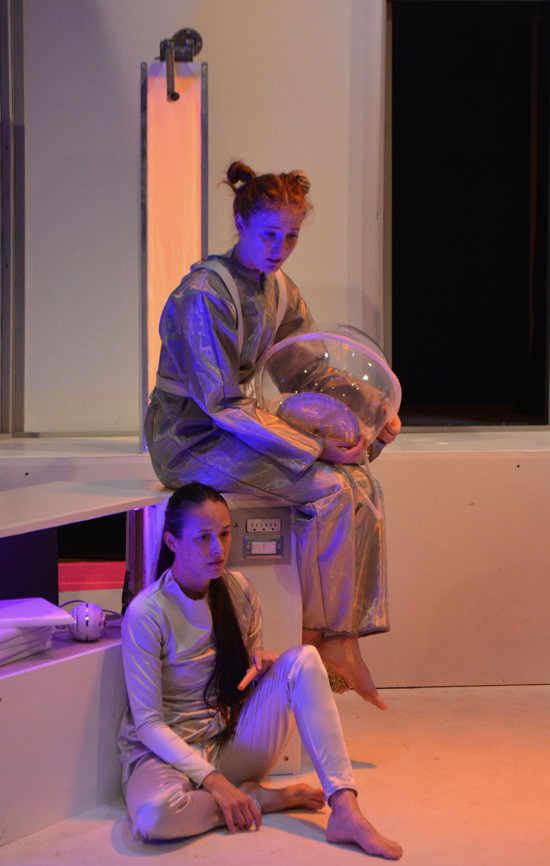
EINHORN: This was meant to be a theatre piece that was caught as well as a theatre piece could be caught. … I haven’t actually stopped and watched the whole thing, I have to admit. I’ve watched pieces of it, like, “okay, that works there, that works there”; somehow I can’t watch from beginning to end yet. But it seems like it captures the show. And there is an interesting thing that happens, because the camera directs where your eye goes rather than you choosing where your eye goes. And there’s an element of, what’s going to happen through that? And there’s an extra story being told just by what Iben [Cenholt], who’s doing the livestream design, decides to choose with the camera. Being the control freak I am, I took over one of the cameras for Sunday’s shows [laughs], so that I could focus on things I thought should be focused on. But Iben was choosing which shot was showing when, and there were three different cameras going. I knew throughout the rehearsal that we were doing to do this, so I also was very aware of “the camera’s going to be here, the camera’s going to be there,” and in my head was always, “where’s the camera going to be to capture this.” That’s not necessarily what Iben chose in the end because she was not in my head as I was doing that. But I was trying to make sure that I gave those options to her.
I do think part of me feels like I don’t want to go back to not livestreaming. Because there’s so many people that you access as a result. There’s been a reluctance to actually go to the theatre for a lot of people. Last month it was much easier, then the Delta variant hit, and a lot of people who said they were going to attend in person said, “maybe I’ll go watch it on video.” People are nervous. So obviously it serves the very specific purpose of this specific time. But there are also people who have disabilities of some sort that don’t allow them to get to the theatre; people who are physically distant; all of these sorts of things, that it creates access for. And I’m really happy that that’s happening. And then of course you have a record, which is nice, and the ability to show it again. I agree with Maggie that it’s an evolving process — if I had my ideal world, every show would be livestreamed, so we’d have that evolution (but there are monetary constraints). So that’s a little bit of a regret. And of course, the control-freak perfectionist in me wants the perfect shot every single time, the perfect moment. That’s never gonna happen with livestream when you’re doing it this way. … It’s never gonna happen in live theatre, but I’ve sort of accepted that in my life. [laughs] But somehow when it’s preserved it makes it more like, “Oh — it’s gonna be imperfect.”
HILOBROW: With the camera you have the illusion of the panopticon — “we could have caught anything!”
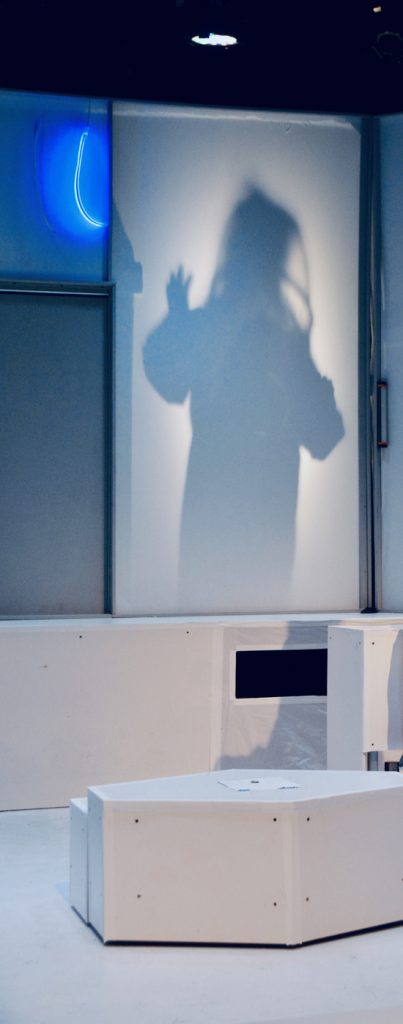
MANN: And I think we’re conditioned, because we do see actual films that are shot the way you shoot a film, with multiple takes, and multiple angles, and then you edit it together, to create this patchwork that is… usually the director’s and the editor’s version of what that piece is, not the actors’. And the theatre is a very different animal and a very different process. But when you see something on film you’re conditioned to think that it was made in that other way, in that more perfect way. And that’s something that we’ve all been dealing with in a lot of different ways with zoom, with — there were a lot of zoom readings that were done earlier in the pandemic, a lot of zoom plays where you’re going, “People are going to approach this as if it’s a film, but we’re filming it with no lighting, and no sound, and in our living rooms” — I think people have had to let go of those benchmarks a little bit, but also it’s shown me how much they are very innate in us, as beings who grew up in a media age. So yeah, any time you put a live thing, that is not shot that way, on film, something in your brain thinks, “This should be perfect” — and you’re never gonna have that. Because it’s live theatre, and that’s the beauty of live theatre. Which is why I didn’t change anything in my process onstage [laughs], because you can’t. There would be no way that I could do my job if I’m thinking about “where’s the camera, is this angle good.” So you just have to forget it.
HILOBROW: As per what Edward was saying about people shrinking back from attending live, I had been looking forward to this as my own return to theatre, but between the time when [the publicist] Emily first got in touch with me about it, and when the time came for it to happen, I was like, I just can’t. And I found the camerawork very satisfying, if it’s any consolation. I thought that it was very naturalistic, and was the closest approximation one could get to me just swiveling my head around and looking at this part of the set, or focusing on that performance. As opposed to just, “we set one camera up on a tripod and walked away,” which, when we even have a record, I think was the only kind of record we have of a whole era of theatre. I think you all adapted in a way that has both permanence and the kind of immediacy that you would want.
Alma Baya runs in-person from August 13-28, 2021; streamed August 14 & 15; and is available on-demand from August 18 to September 19, details here.
Logo image (detail) designed by Clinton Corbett; photos (featuring Cast B: l-r, Halter, Cino and Mann as seen in top pic) all by Arthur Cornelius
MORE POSTS by ADAM McGOVERN: OFF-TOPIC (2019–2025 monthly) | textshow (2018 quarterly) | PANEL ZERO (comics-related Q&As, 2018 monthly) | THIS: (2016–2017 weekly) | PEOPLE YOU MEET IN HELL, a 5-part series about characters in McGovern’s and Paolo Leandri’s comic Nightworld | Two IDORU JONES comics by McGovern and Paolo Leandri | BOWIEOLOGY: Celebrating 50 years of Bowie | ODD ABSURDUM: How Felix invented the 21st century self | KOJAK YOUR ENTHUSIASM: FAWLTY TOWERS | KICK YOUR ENTHUSIASM: JACKIE McGEE | NERD YOUR ENTHUSIASM: JOAN SEMMEL | SWERVE YOUR ENTHUSIASM: INTRO and THE LEON SUITES | FIVE-O YOUR ENTHUSIASM: JULIA | FERB YOUR ENTHUSIASM: KIMBA THE WHITE LION | CARBONA YOUR ENTHUSIASM: WASHINGTON BULLETS | KLAATU YOU: SILENT RUNNING | CONVOY YOUR ENTHUSIASM: QUINTET | TUBE YOUR ENTHUSIASM: HIGHWAY PATROL | #SQUADGOALS: KAMANDI’S FAMILY | QUIRK YOUR ENTHUSIASM: LUCKY NUMBER | CROM YOUR ENTHUSIASM: JIREL OF JOIRY | KERN YOUR ENTHUSIASM: Data 70 | HERC YOUR ENTHUSIASM: “Freedom” | KIRK YOUR ENTHUSIASM: Captain Camelot | KIRB YOUR ENTHUSIASM: Full Fathom Five | A 5-part series on Jack Kirby’s Fourth World mythos | Reviews of Annie Nocenti’s comics Katana, Catwoman, Klarion, and Green Arrow | The curated series FANCHILD | To see all of Adam’s posts, including HiLo Hero items on Lilli Carré, Judy Garland, Wally Wood, and others: CLICK HERE
